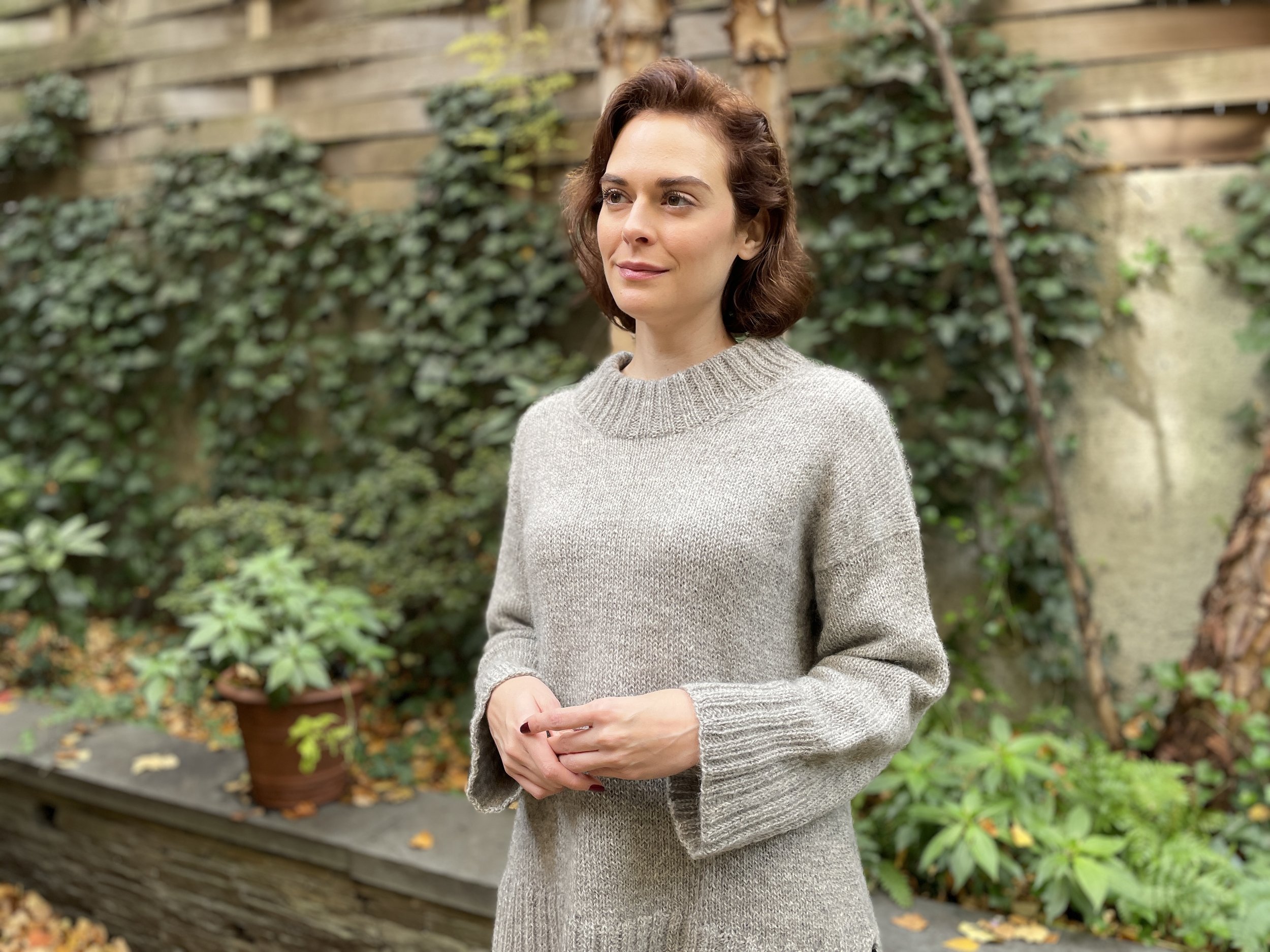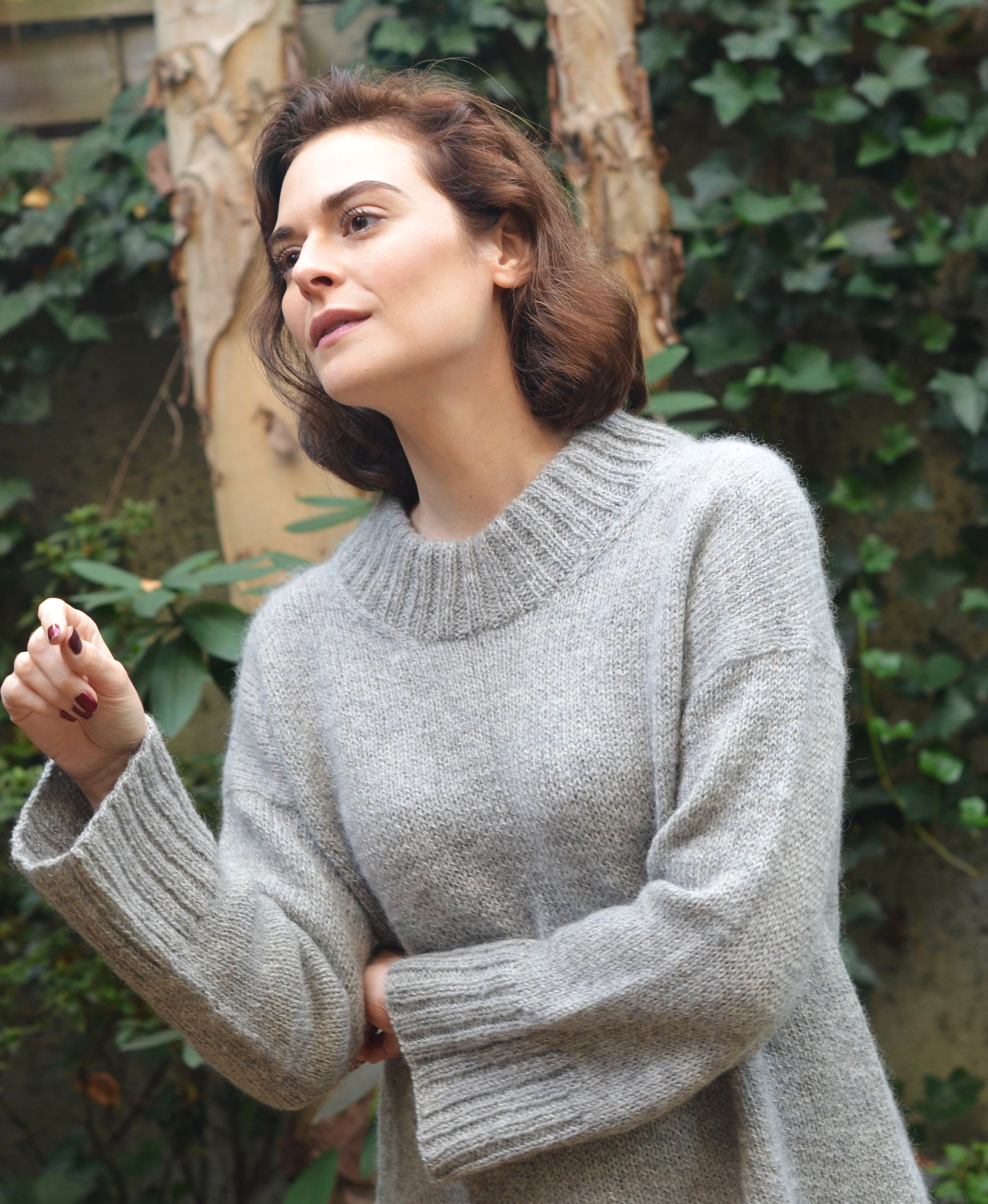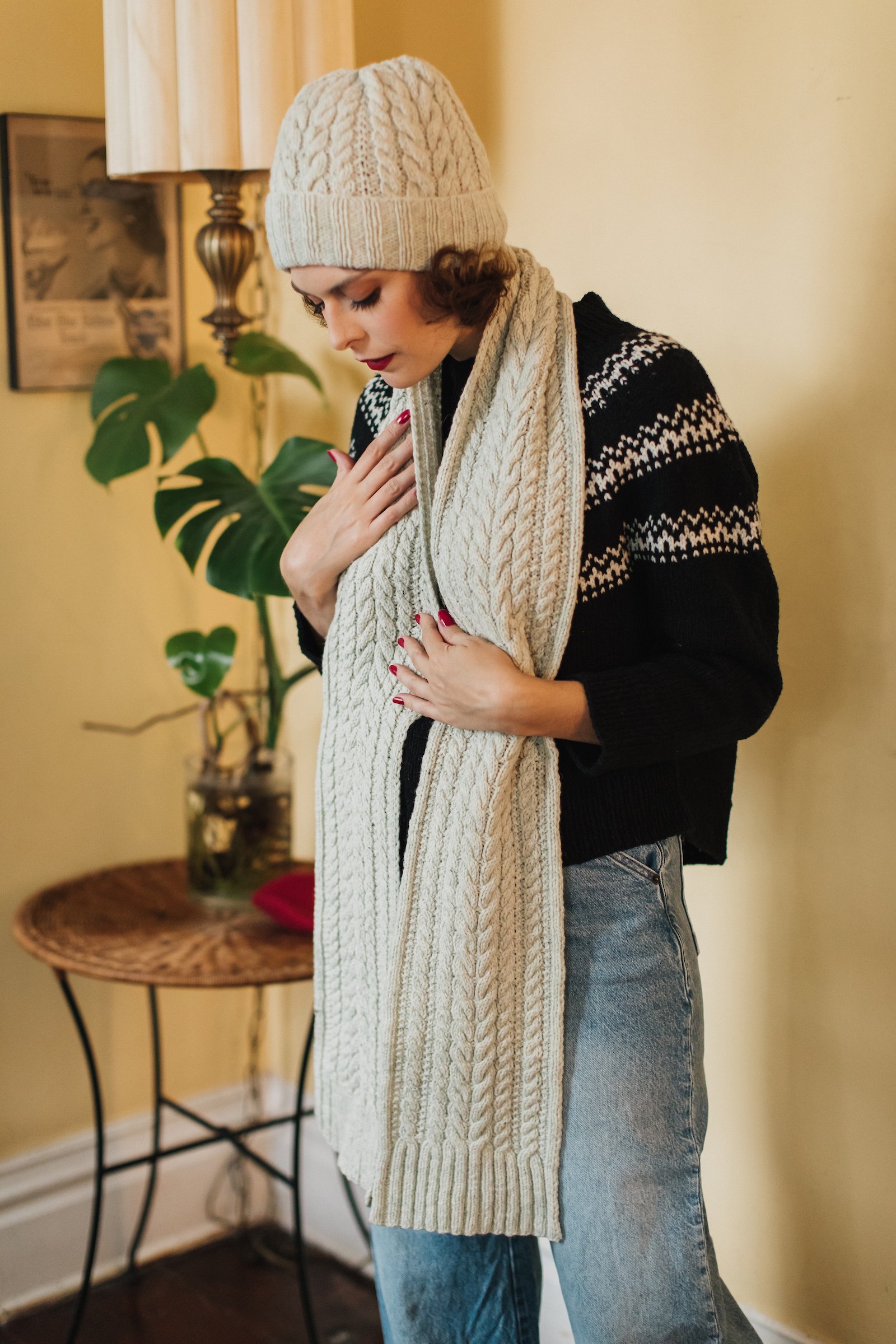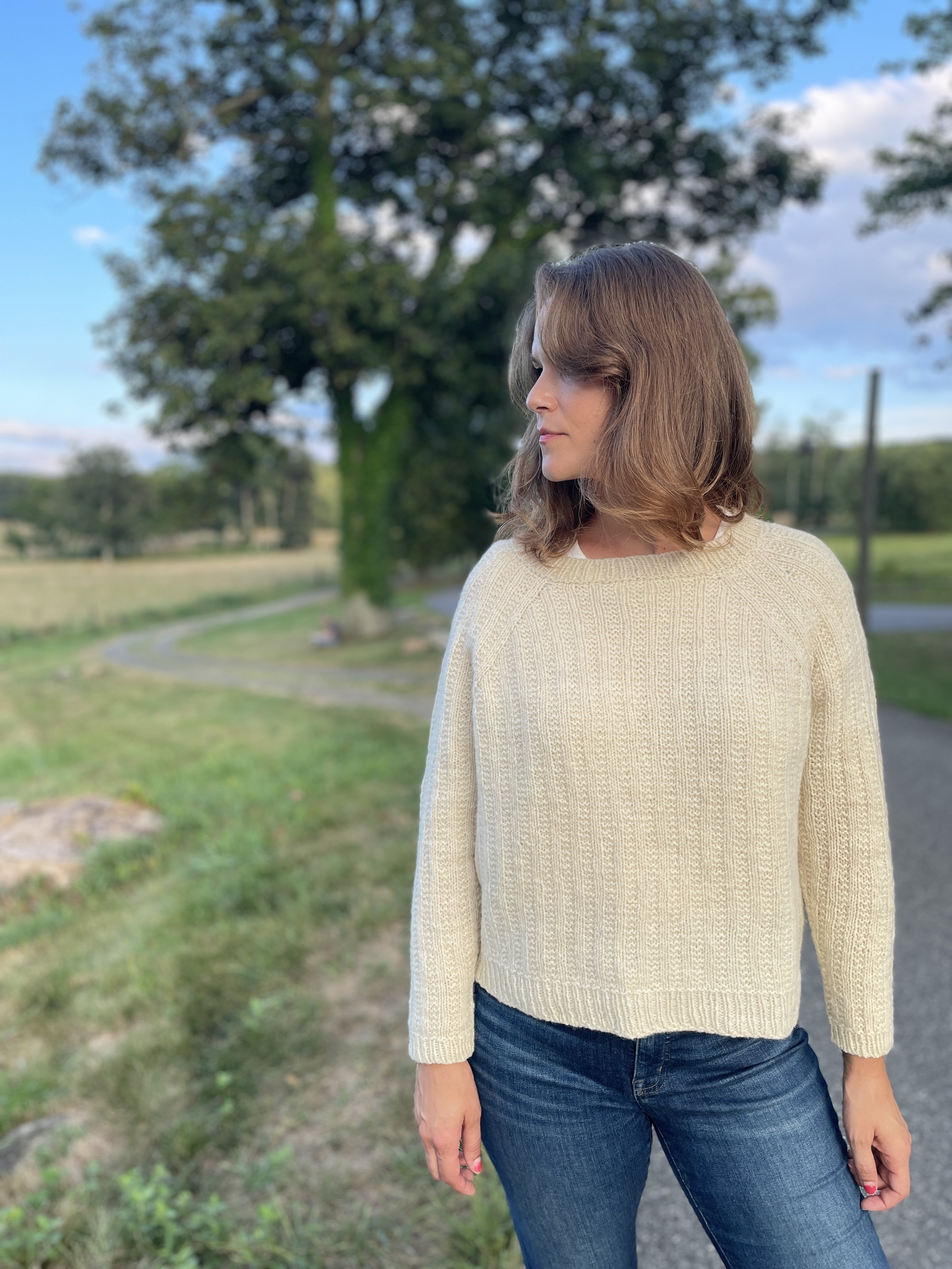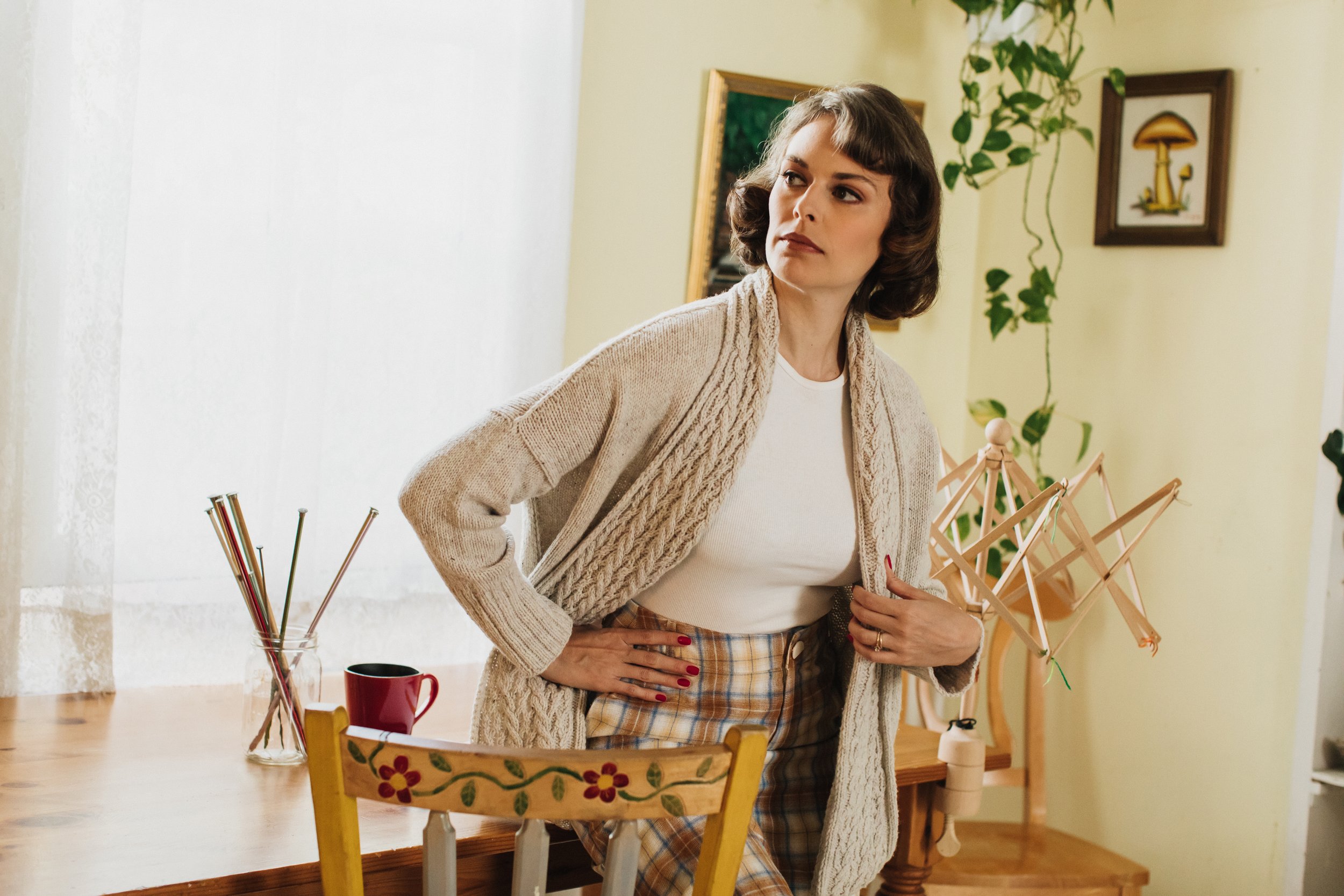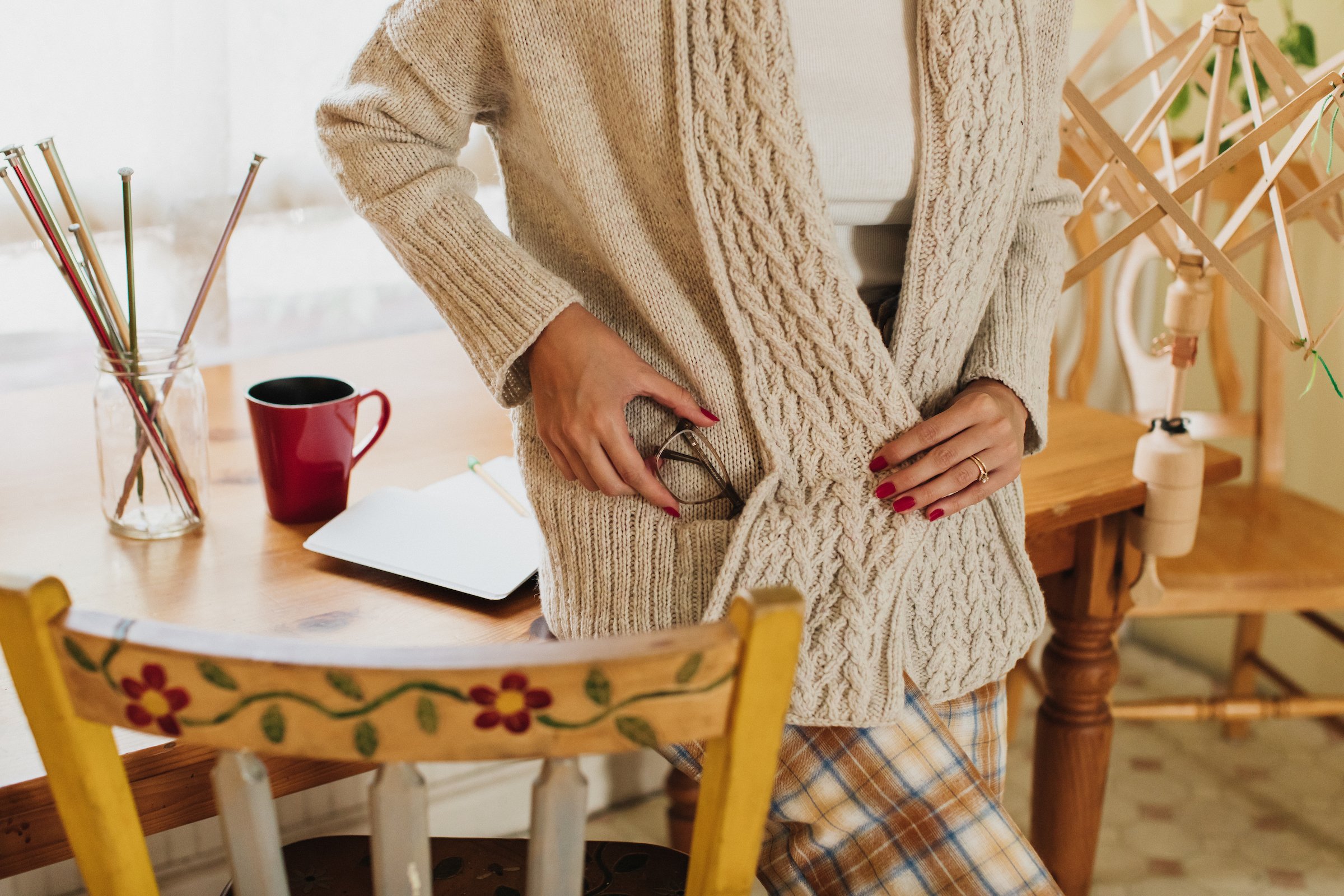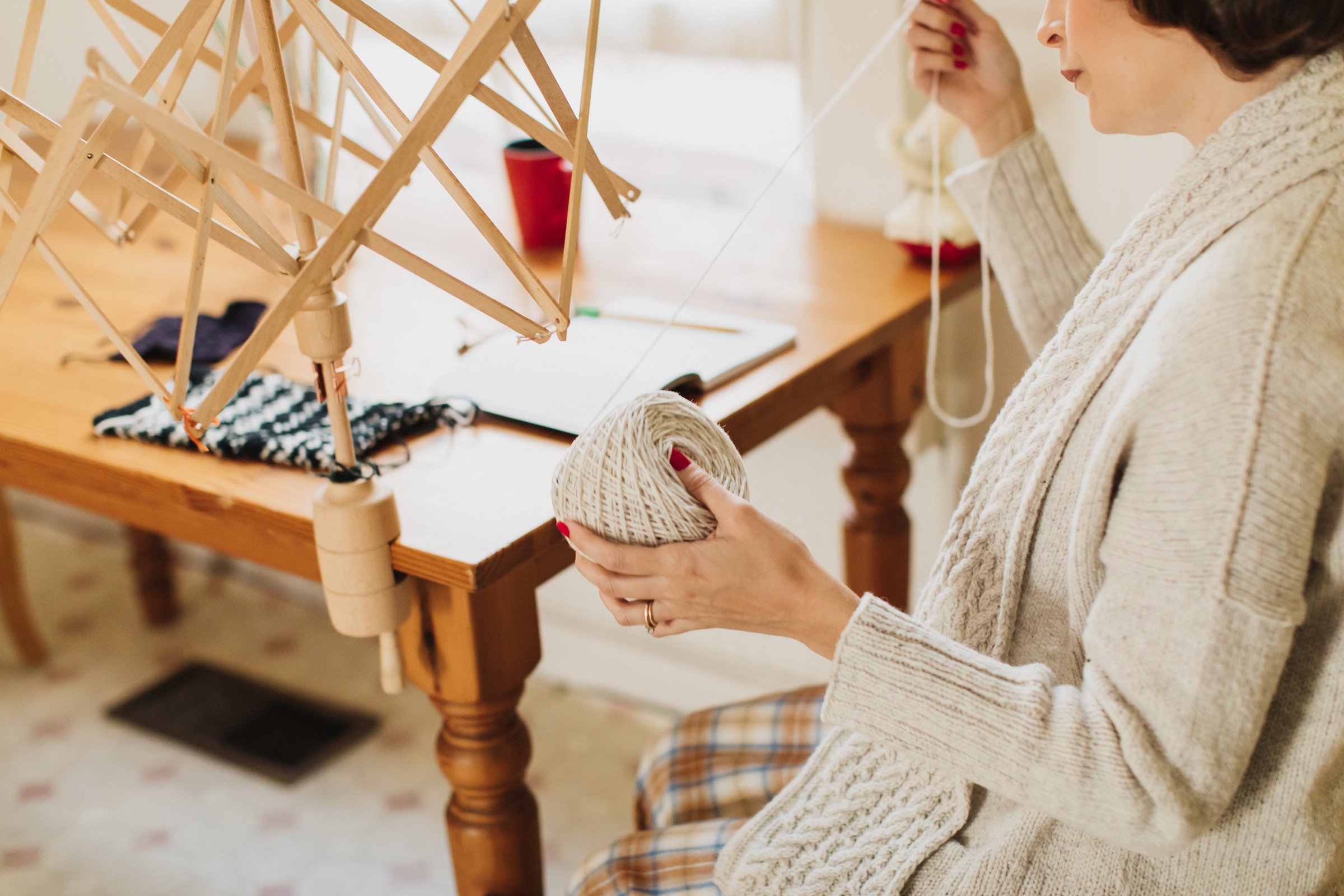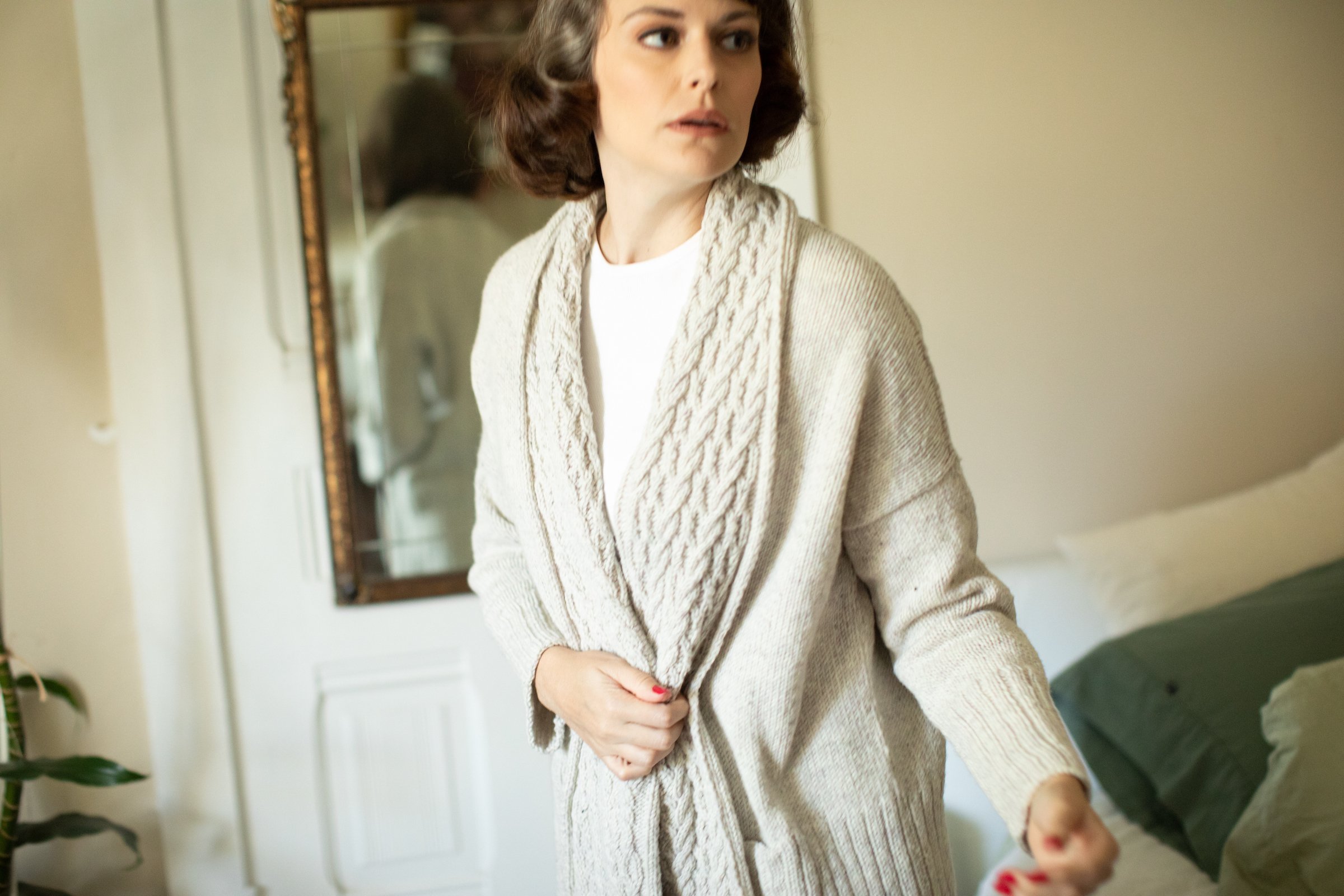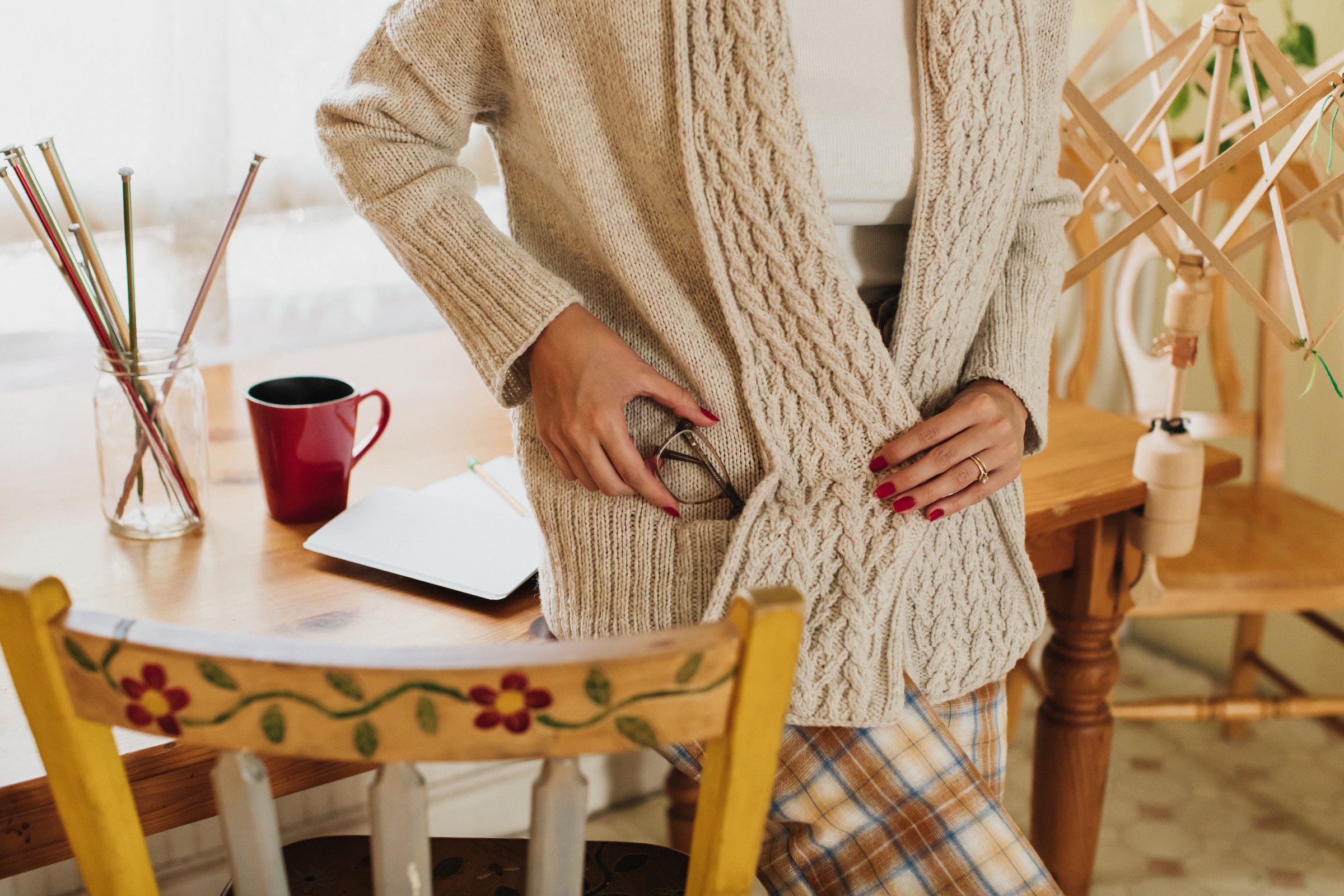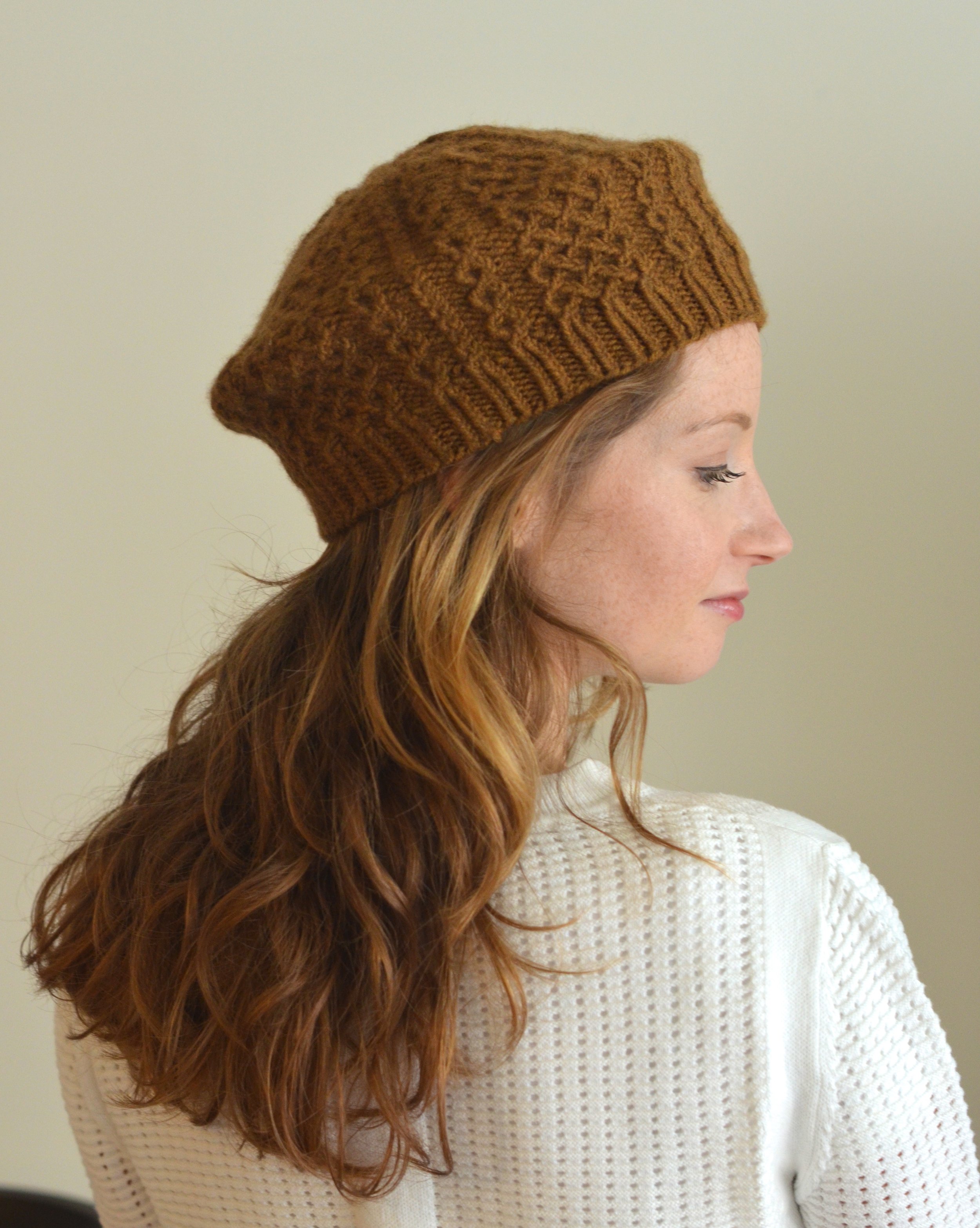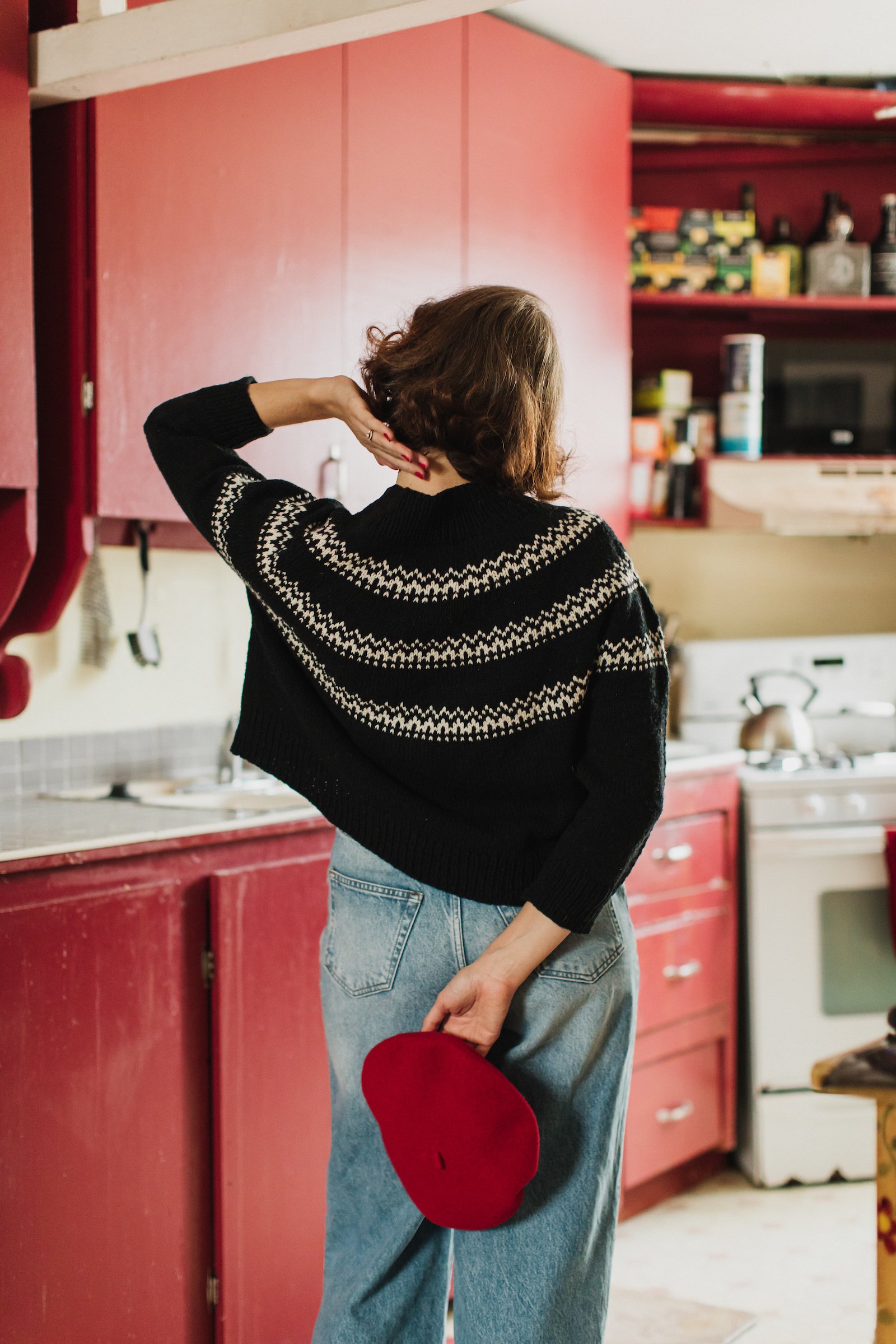Freya Top-Down Tunic Sweater (DK)
Freya is a drop shoulder tunic with subtle detailing at back shoulder, a wide rounded neck and a split hem. Length of body and sleeves are fully adjustable so this design can be knit to sweater or tunic length. Notes are included for how to measure for total length and how much yardage you need for any length adjustments.
Freya was designed as an approachable pattern for new sweater knitters, as well an introduction to working with Gotland wool. A relaxed fit and lots of size options mean that the sweater will be wearable even if your gauge is not spot on. Notes are provided for how to follow gauge guidelines if you are substituting yarn. Additionally, if you would like to use a thicker/heavier yarn, see the other version of the pattern, Freya Top-Down Tunic Sweater (Worsted).
SIZES 1 (2, 3, 4, 5, 6, 7, 8, 9, 10)
FINISHED SIZE 35 (38½, 42, 45, 48½, 52, 54½, 58, 62, 64½)“ bust circumference
Intended Ease at Bust: + 4–10” (meaning choose a size that is 4–10” larger than your bust measurement for the intended fit, or choose more or less ease depending on your fit preferences).
Sample measures 42” at bust and is worn with 6” ease on model.
YARN
Six Dutchess Farm (100% Pure Gotland wool, naturally colored; 240 yds/ 100 g)
5 (6, 6, 6, 7, 7, 8, 8, 9, 9) skeins; sample shown in color Mattina
Yardages have been padded by 10% to accommodate differences in knitting style
NEEDLES
Main Fabric Needle: One 32” circular and one 16” circular or one set double-pointed
Suggested size: US 8 (5.0 mm)
Ribbing Needle: One 32” circular and one 16” circular or one set double-pointed one size smaller than gauge needle Suggested size: US 7 (4.5 mm)
Stitch Pick-Up Needle: One 32” circular 3 sizes smaller than Main Fabric Needle.
Suggested size: US 5 (3.75 mm)
Adjust needle size if necessary to obtain correct gauge. You may substitute 40” circular needles if desired for working the sleeves in using Magic Loop.
GAUGE
Gotland Working Gauge:16 stitches and 24 rows = 4” in stockinette on larger needle, on the needles
Gotland Blocked Gauge: 18 stitches and 22 rows = 4” in stockinette on larger needle, relaxed after wet-blocking
Note that due to the nature of this yarn, gauge will change after blocking as the yarn will full and shrink up a bit. All measurements in the pattern use the unblocked measurements accompanied by the approximate number of rows/rounds for reference––this will reflect the measurements of the piece while it is being knit. The schematic provides the finished blocked measurements.
NOTIONS AND TOOLS
• blunt tapestry needle
• stitch markers
• small amount of contrasting waste yarn for finishing collar
TECHNIQUES USED
• long-tail cast on
• knitting in the round
• using double-pointed needles or magic loop
• increasing and decreasing
CONSTRUCTION OVERVIEW
• Sweater begins by casting on stitches for the back neck.
• The back is worked flat and stitches are increased at each edge on both right and wrong side rows to create the shoulders.
• When shoulder width is reached, knitting continues straight until the armhole depth is reached.
• Back stitches are put on hold and the front shoulders are worked flat one at a time with incorporated neck increases.
• When the neck depth is reached stitches are cast on for the center neck and the front continues as one piece of flat knitting until armhole depth reached. Subtle decreasing is worked at the armhole edge for an improved fit.
• Once armhole depth is reached on back and front pieces, the work is joined in the round and knit until the desired length, splitting into flat knitting again to work the ribbed hem vent. Back ribbing is longer than front.
• Sleeves are picked up from the armhole edges and worked towards the cuff.
• Stitches are picked up around the neckline to work the collar. Collar is knit to twice the desired length then secured to the WS using whip stitch (instructions provided).
Freya is a drop shoulder tunic with subtle detailing at back shoulder, a wide rounded neck and a split hem. Length of body and sleeves are fully adjustable so this design can be knit to sweater or tunic length. Notes are included for how to measure for total length and how much yardage you need for any length adjustments.
Freya was designed as an approachable pattern for new sweater knitters, as well an introduction to working with Gotland wool. A relaxed fit and lots of size options mean that the sweater will be wearable even if your gauge is not spot on. Notes are provided for how to follow gauge guidelines if you are substituting yarn. Additionally, if you would like to use a thicker/heavier yarn, see the other version of the pattern, Freya Top-Down Tunic Sweater (Worsted).
SIZES 1 (2, 3, 4, 5, 6, 7, 8, 9, 10)
FINISHED SIZE 35 (38½, 42, 45, 48½, 52, 54½, 58, 62, 64½)“ bust circumference
Intended Ease at Bust: + 4–10” (meaning choose a size that is 4–10” larger than your bust measurement for the intended fit, or choose more or less ease depending on your fit preferences).
Sample measures 42” at bust and is worn with 6” ease on model.
YARN
Six Dutchess Farm (100% Pure Gotland wool, naturally colored; 240 yds/ 100 g)
5 (6, 6, 6, 7, 7, 8, 8, 9, 9) skeins; sample shown in color Mattina
Yardages have been padded by 10% to accommodate differences in knitting style
NEEDLES
Main Fabric Needle: One 32” circular and one 16” circular or one set double-pointed
Suggested size: US 8 (5.0 mm)
Ribbing Needle: One 32” circular and one 16” circular or one set double-pointed one size smaller than gauge needle Suggested size: US 7 (4.5 mm)
Stitch Pick-Up Needle: One 32” circular 3 sizes smaller than Main Fabric Needle.
Suggested size: US 5 (3.75 mm)
Adjust needle size if necessary to obtain correct gauge. You may substitute 40” circular needles if desired for working the sleeves in using Magic Loop.
GAUGE
Gotland Working Gauge:16 stitches and 24 rows = 4” in stockinette on larger needle, on the needles
Gotland Blocked Gauge: 18 stitches and 22 rows = 4” in stockinette on larger needle, relaxed after wet-blocking
Note that due to the nature of this yarn, gauge will change after blocking as the yarn will full and shrink up a bit. All measurements in the pattern use the unblocked measurements accompanied by the approximate number of rows/rounds for reference––this will reflect the measurements of the piece while it is being knit. The schematic provides the finished blocked measurements.
NOTIONS AND TOOLS
• blunt tapestry needle
• stitch markers
• small amount of contrasting waste yarn for finishing collar
TECHNIQUES USED
• long-tail cast on
• knitting in the round
• using double-pointed needles or magic loop
• increasing and decreasing
CONSTRUCTION OVERVIEW
• Sweater begins by casting on stitches for the back neck.
• The back is worked flat and stitches are increased at each edge on both right and wrong side rows to create the shoulders.
• When shoulder width is reached, knitting continues straight until the armhole depth is reached.
• Back stitches are put on hold and the front shoulders are worked flat one at a time with incorporated neck increases.
• When the neck depth is reached stitches are cast on for the center neck and the front continues as one piece of flat knitting until armhole depth reached. Subtle decreasing is worked at the armhole edge for an improved fit.
• Once armhole depth is reached on back and front pieces, the work is joined in the round and knit until the desired length, splitting into flat knitting again to work the ribbed hem vent. Back ribbing is longer than front.
• Sleeves are picked up from the armhole edges and worked towards the cuff.
• Stitches are picked up around the neckline to work the collar. Collar is knit to twice the desired length then secured to the WS using whip stitch (instructions provided).
Freya is a drop shoulder tunic with subtle detailing at back shoulder, a wide rounded neck and a split hem. Length of body and sleeves are fully adjustable so this design can be knit to sweater or tunic length. Notes are included for how to measure for total length and how much yardage you need for any length adjustments.
Freya was designed as an approachable pattern for new sweater knitters, as well an introduction to working with Gotland wool. A relaxed fit and lots of size options mean that the sweater will be wearable even if your gauge is not spot on. Notes are provided for how to follow gauge guidelines if you are substituting yarn. Additionally, if you would like to use a thicker/heavier yarn, see the other version of the pattern, Freya Top-Down Tunic Sweater (Worsted).
SIZES 1 (2, 3, 4, 5, 6, 7, 8, 9, 10)
FINISHED SIZE 35 (38½, 42, 45, 48½, 52, 54½, 58, 62, 64½)“ bust circumference
Intended Ease at Bust: + 4–10” (meaning choose a size that is 4–10” larger than your bust measurement for the intended fit, or choose more or less ease depending on your fit preferences).
Sample measures 42” at bust and is worn with 6” ease on model.
YARN
Six Dutchess Farm (100% Pure Gotland wool, naturally colored; 240 yds/ 100 g)
5 (6, 6, 6, 7, 7, 8, 8, 9, 9) skeins; sample shown in color Mattina
Yardages have been padded by 10% to accommodate differences in knitting style
NEEDLES
Main Fabric Needle: One 32” circular and one 16” circular or one set double-pointed
Suggested size: US 8 (5.0 mm)
Ribbing Needle: One 32” circular and one 16” circular or one set double-pointed one size smaller than gauge needle Suggested size: US 7 (4.5 mm)
Stitch Pick-Up Needle: One 32” circular 3 sizes smaller than Main Fabric Needle.
Suggested size: US 5 (3.75 mm)
Adjust needle size if necessary to obtain correct gauge. You may substitute 40” circular needles if desired for working the sleeves in using Magic Loop.
GAUGE
Gotland Working Gauge:16 stitches and 24 rows = 4” in stockinette on larger needle, on the needles
Gotland Blocked Gauge: 18 stitches and 22 rows = 4” in stockinette on larger needle, relaxed after wet-blocking
Note that due to the nature of this yarn, gauge will change after blocking as the yarn will full and shrink up a bit. All measurements in the pattern use the unblocked measurements accompanied by the approximate number of rows/rounds for reference––this will reflect the measurements of the piece while it is being knit. The schematic provides the finished blocked measurements.
NOTIONS AND TOOLS
• blunt tapestry needle
• stitch markers
• small amount of contrasting waste yarn for finishing collar
TECHNIQUES USED
• long-tail cast on
• knitting in the round
• using double-pointed needles or magic loop
• increasing and decreasing
CONSTRUCTION OVERVIEW
• Sweater begins by casting on stitches for the back neck.
• The back is worked flat and stitches are increased at each edge on both right and wrong side rows to create the shoulders.
• When shoulder width is reached, knitting continues straight until the armhole depth is reached.
• Back stitches are put on hold and the front shoulders are worked flat one at a time with incorporated neck increases.
• When the neck depth is reached stitches are cast on for the center neck and the front continues as one piece of flat knitting until armhole depth reached. Subtle decreasing is worked at the armhole edge for an improved fit.
• Once armhole depth is reached on back and front pieces, the work is joined in the round and knit until the desired length, splitting into flat knitting again to work the ribbed hem vent. Back ribbing is longer than front.
• Sleeves are picked up from the armhole edges and worked towards the cuff.
• Stitches are picked up around the neckline to work the collar. Collar is knit to twice the desired length then secured to the WS using whip stitch (instructions provided).
